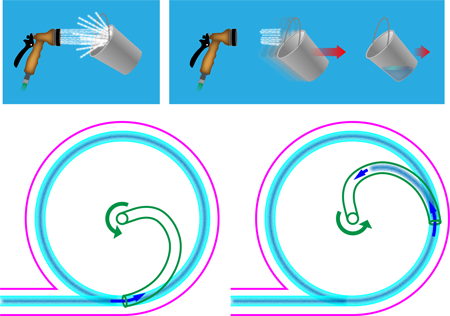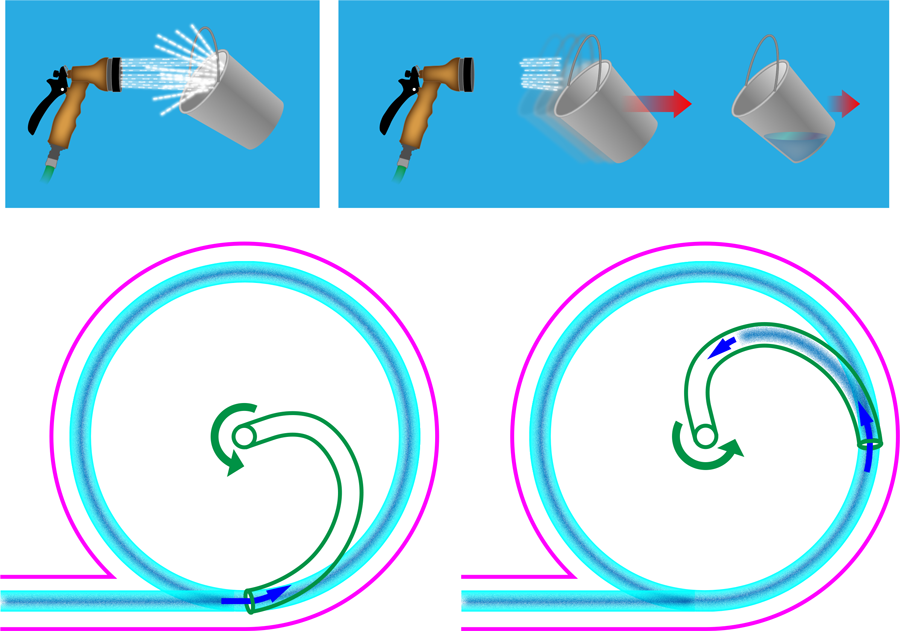Slowing Continuous Molecular Beams in a Rotating Spiral
Developments of the past decades in cold-atom physics have motivated molecular physicists to also venture into temperature domains below 1 kelvin [1,2]. Inherently, molecular interactions are more complex than those between atoms, and the study of cold molecules opens up a plethora of new research areas in, e.g., quantum computation or molecular spectroscopy and scattering. However, the complexity of molecules presents a challenge for cold-molecule production because some of the main techniques for atom slowing and cooling—based on laser interactions—are not easily adapted. A new technique may help in this endeavor by using a spinning centrifuge to slow down a continuous beam of molecules. As described in Physical Review Letters [3], electric fields guide polar molecules through a spiral-shaped track that rotates around an axis. This continuous decelerator for molecules may be coupled to other devices to produce cold-molecule samples, as well as molecular beams with tunable velocities.
Current efforts to generate ultracold molecules often follow the basic atom cooling recipe, which is a three-step procedure: (a) preparation of an atom beam at high temperature (and speeds), (b) slowing/cooling combined with trapping, and (c) further cooling in the trap. An active field of research in the past decades has been to try to extend the above atom procedure to molecules. The first step, the preparation of a molecule beam, is particularly interesting when considering that supersonic expansions—sometimes combined with electric discharges or laser ablation—are able to generate internally and translationally cold molecules, albeit at high lab-frame velocities. Alternatively, one can accomplish step (a) with effusive or hydrodynamically enhanced sources, possibly at cryogenic temperatures.
The second step, slowing and cooling molecules, has received much attention during the past decades, resulting in several techniques to slow down fast molecules or molecular beams using, for example, strong inhomogeneous electric, magnetic, or optical fields, or cold buffer gases. Many of these developments have arisen in the context of molecular spectroscopy and dynamics studies, which often employ pulsed sources and pulsed detection schemes. Accordingly, molecular decelerators have so far been pulsed themselves [4], normally producing short pulses of cold molecules and often operating at duty cycles of 0.1% or less.
A common pulsed deceleration method is Stark deceleration, which uses the electric field dependence of the energy levels in polar molecules. When the electric field increases, the potential energy of some of these levels increases. For molecules moving in inhomogenous electric fields this leads to a corresponding loss in kinetic energy. Molecules like ammonia gain around 0.1 milli-electron-volt of potential energy while moving into a field of 100 kilovolts per centimeter (which is a typical field strength achieved in such setups without excessively complicated installations). This leads to somewhat less than a 1% decrease in the speed for molecules initially moving at a few hundred meters per second. To produce a greater amount of deceleration, pulsed Stark deceleration methods effectively expose molecules to an electric field ramp that is pulled back as the molecules try to climb it [5,6]. This results in a constant force against the propagation of the molecules, which is similar to capturing a squirt of water with a backward moving bucket, as sketched in the top of Fig. 1. The bucket needs to catch the water while moving at the water’s initial velocity and only then slowly start to decelerate (otherwise the water splashes out before it can be slowed). Because of this velocity-matching requirement, the bucket only works for pulses of water but not for a continuous jet, just like the receding electric field in conventional Stark deceleration only works for pulses of molecules.
In order to accommodate a continuous beam of molecules, as it is ideal for their experiment, Sotir Chervenkov and colleagues at the Max Planck Institute for Quantum Optics (MPQ) in Garching, Germany, designed a new molecule decelerator that, for the first time, allows for the deceleration of a continuous beam [3]. The device consists of electrostatic guides that work like tubes, controlling the direction of a beam of polar molecules. The guiding force is produced by inhomogenous electric fields that interact with the dipole moment of the molecule, just like the forces in a Stark decelerator. The outer part of the guide entrains the beam into a circular path, while an inner part, in the form of a spiral, rotates around the center of the circle. Molecules moving along the circular path at sufficient speed enter the rotating spiral guide and exit through an opening at the fixed axis point (bottom of Fig. 1). Inside the spiral guide, the molecules feel the confining force from the electrostatic potential, but due to the constant bend in the guide they also feel a force against their direction of motion. The molecules that exit the spiral guide are decelerated by an amount that depends on the guide rotation speed but is independent of the initial velocity. The final velocity distribution is identical to the original one, but shifted to lower velocity.
The beam emerging from the device can have a very low average velocity and a narrow velocity distribution, but the particle density is similar to the one from the original beam. In particular, this system can decelerate nearly all the velocities in a Maxwell Boltzmann distribution from an effusive beam, such that the emerging sample has low translational temperatures at densities corresponding to that of the most probable velocity in the original beam. The researchers demonstrated their new method on CF3H, reducing the velocity in the beam from around 200 to below 15 meters per second. They also test their system with other polar molecules. One can indeed expect this to be a fairly general method for the continuous deceleration of polar molecules in the future.
One advantage of having a continuous decelerator is that it may feed into efforts to cool trapped molecules, i.e., step (c) from above. Cooling of atoms usually is done via laser cooling, but this cannot be adapted to molecules in a straightforward manner. Closed cycling transitions thus far have only been developed for select molecules, and laser cooling to date has been demonstrated only for SrF [7]. Related alternatives are magneto-optical cooling [8] or electro-optical cooling, recently introduced by the MPQ group [9]. They used a combination of electric fields and cycling between different molecular states to cool trapped molecules. The key point of this method lies in the use of electric fields to remove the energy, rather than the photon momentum alone, thus reducing the number of photons required for efficient phase-space compression.
For the electro-optical cooling device to work, one ideally loads a high flux of molecules into the trap for accumulation and cooling. Translational temperatures of the incoming molecules should be low to enable trapping, and the flux should be high to reach sufficient densities. Previously, the MPQ group used a velocity filter [10] to feed their trap with translationally cold polar molecules. In velocity filters, the low velocity tail of a Maxwell-Boltzmann velocity distribution is isolated by sending the entire sample through a bent guide that ejects high-velocity molecules whose centrifugal force is too great for the confining force in the guide. The downside of such a filter is that in most cases the highest probability density of the velocity distribution is at velocities above the threshold for guiding, resulting in relatively low flux.
Therefore, a particularly interesting application will be to replace the velocity filter with the newly developed continuous decelerator in order to improve the efficiency of the molecular cooling. Starting from much higher densities will be highly beneficial in producing dense samples of cold molecules, which in turn may be sufficient to observe intermolecular collisions and even evaporative cooling. But applications can be envisioned in different areas as well. Many experiments outside the field of cold molecules require molecular beams—pulsed or continuous—at tunable velocities, and for a long time, the main possibilities were supersonic expansions with variable temperature and carrier gas or mechanical beam choppers in combination with continuous beams. With the advent of Stark deceleration and other similar methods, much finer tunability became possible but often at the cost of reduced flux. In contrast, the longitudinal velocity acceptance of the centrifuge presented here is much larger, and potentially the entire pulse of a supersonic expansion can be transferred to any desired velocity. The resulting sample would then have a similar density (and velocity spread) as the original expansion. We can look forward to many new applications with cold molecules in the near future.
References
- Cold Molecules: Theory, Experiment, Applications, edited by R. V. Krems, B. Friedrich, and W. C. Stwalley (CRC Press, Boca Raton, 2009)[Amazon][WorldCat]
- 2012 Ultracold Molecules Vol. 112, edited by D. S. Jin and J. Ye (Chemical Reviews, ACS Publications, 2012)
- S. Chervenkov, X. Wu, J. Bayerl, A. Rohlfes, T. Gantner, M. Zeppenfeld, and G. Rempe, “Continuous Centrifuge Decelerator for Polar Molecules,” Phys. Rev. Lett. 112, 013001 (2014)
- S. Y. T. van de Meerakker, H. L. Bethlem, N. Vanhaecke, and G. Meijer, “Manipulation and Control of Molecular Beams,” Chem. Rev. 112, 4828 (2012)
- H. L. Bethlem, G. Berden, and G. Meijer, “Decelerating Neutral Dipolar Molecules,” Phys. Rev. Lett. 83, 1558 (1999)
- A. Osterwalder, S. A. Meek, H. Haak, and G. Meijer, “Deceleration of Neutral Molecules in Macroscopic Traveling Traps,” Phys. Rev. A 81, 051401 (2010)
- E. S. Shuman, J. F. Barry, and D. DeMille, “Laser Cooling of a Diatomic Molecule,” Nature 467, 820 (2010)
- M. T. Hummon, M. Yeo, B. K. Stuhl, A. L. Collopy, Y. Xia, and J. Ye, “2D Magneto-Optical Trapping of Diatomic Molecules,” Phys. Rev. Lett. 110, 143001 (2013)
- M. Zeppenfeld, B. G. U. Englert, R. Glöckner, A. Prehn, M. Mielenz, C. Sommer, L. D. Van Buuren, M. Motsch, and G. Rempe, “Sisyphus Cooling of Electrically Trapped Polyatomic Molecules,” Nature 491, 570 (2012)
- S. A. Rangwala, T. Junglen, T. Rieger, P. W. H. Pinkse, and G. Rempe, “Continuous Source of Translationally Cold Dipolar Molecules,” Phys. Rev. A 67, 043406 (2003)





